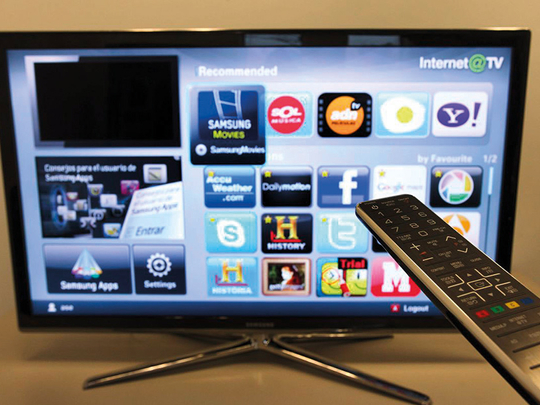
New York: Targeted ads that seem to follow you everywhere online may soon be doing the same on your TV.
The US Federal Communications Commission is poised to approve a new broadcast standard that will let broadcasters do something cable TV companies already do: harvest data about what you watch so advertisers can customise pitches. The prospect alarms privacy advocates, who say there are no rules setting boundaries for how broadcasters handle personal information.
“If the new standard allows broadcasters to collect data in a way they haven’t before, I think consumers should know about that,” Jonathan Schwantes, senior policy counsel for Consumers Union. “What privacy protections will apply to that data, and what security protections?”
For broadcasters, Next Gen TV represents an advance into the digital world that for decades has been siphoning viewers away to the likes of Facebook Inc., Netflix Inc., Google’s YouTube and Amazon.com Inc.’s Prime video service.
Sinclair Broadcast Group Inc. and other TV station owners say the new standard, known as Next Gen TV, will provide sharper pictures and video on demand. It will also allow them to track viewers of their programming on tablets and other platforms.
This could prove lucrative for ad sales. For decades, TV stations sold commercials based on broad demographics, like how many 18-to-49-year-old women watched ‘Law and Order’. Data collected via Next Gen TV can help them up their game, much as cable providers use data from set-top boxes, and websites rely on browsing history to target ads.
Because the new standard is designed to be compatible with tablets and mobile phones, broadcasters expect to reach viewers away from their home TV sets — and learn their habits.
“We’ll know where you are, who you are, and what you’re doing — just like you do now, just like everybody does now, the internet does, or Google, or a Facebook,” Sinclair Executive Chairman David Smith told investors at the Wells Fargo Technology, Media & Telecom Conference. “We will have perfect data all the time.”
Cable companies have legal obligations to safeguard subscriber information, such as names and addresses, from unauthorised disclosure. Next Gen TV should have the same rules, Consumers Union and other groups said in a filing, and consumers also should be given a choice in how information about their viewing is used.
FCC Chairman Ajit Pai, who proposed allowing the new broadcast standard a month after being nominated by President Donald Trump, told lawmakers hearing that the FCC is “looking just at the technical standard” and may look at privacy concerns later. In a speech, Pai likened critics of Next Gen TV to opponents of the automobile more than a century ago, saying they dwell on challenges instead of embracing the benefits of innovation.
“They want to impose extensive government regulation that could strangle Next Gen TV in its infancy,” Pai said, adding that critics are rooted in “fear and opportunism, not freedom and opportunity.”
Sinclair will have 233 stations if its merger with Tribune Media Co. is approved by antitrust regulators. It also has formed a partnership to share airwaves with Nexstar Media Group Inc.’s 170 stations. Private-equity owned Spanish-language broadcaster Univision Holdings Inc. also has joined the alliance, which Sinclair says covers 92 per cent of the country.
The Maryland-based broadcaster also holds potentially lucrative patents on the technology and is still assessing the revenue. Cable providers, TV manufacturers and broadcasters using the system may have to pay Sinclair royalties.
Pai’s proposed rules for the service are likely to be approved because he leads the FCC’s Republican majority, and controls the agency’s agenda. The rules would allow — and not require stations to use the new standard.
Approval by the FCC would come as the agency also decides whether to loosen restrictions on owning multiple TV stations in a local market — a long-sought goal of broadcasters.
“This is a landmark development for our industry,” Sinclair CEO Chris Ripley told investors. “Reforming the ownership rules and allowing for technological innovation are both necessary for the future of over-the-air broadcasting.”
The privacy implications need more study, Representative Debbie Dingell, a Michigan Democrat, said in a letter to the FCC’s Pai.
Dingell acknowledged “significant benefits” of the new technology. But, she added, the prospect of targeted advertisements “raises questions about how advertisers and broadcasters will gather the demographic information from consumers” and “what privacy protections will be in place.”
“It’s a matter of giving broadcasters capabilities others already have,” said Dave Arland, a spokesman for the Advanced Television Systems Committee that’s developing the new standard. “Broadcasters see the opportunity to have new ways of measuring who’s watching what.”
Under the new standard, TV stations will be transmitting in a different format than they do now. Those who rely on antennas for over-the-air reception will need to buy a new set or a gadget to convert the Next Gen signals. About 12 million TV households relied exclusively on over-the-air reception in 2015, according to the most recent statistics from the FCC.
Cable providers would need new equipment, from the head-ends where they receive broadcast signals through to consumers’ set-top boxes in order to pass NextGen TV signals through to viewers, the NETA-the Internet and Television Association, representing the biggest operators, said.
It will be a “massive and very expensive” prospect that could bring higher rates for consumers, according to the filing. The trade group’s members include top cable provider Comcast Corp. and No. 2 Charter Communications Inc.
The association said engineers are still working out how to convert the new standard for current TVs and didn’t say if customers will be charged for new set-top boxes.
Under the FCC’s proposed rules broadcasters using Next Gen TV also need to keep sending today’s signals, and to offer the same programming on both streams for five years.
After that, TV stations would be free to shift popular shows to the Next Gen stream only — essentially stranding older TV sets with lesser programming.
“It’s a tax on every household with a television,” said Jessica Rosenworcel, a member of the FCC, said. “Every one of us will need to replace existing television sets or buy new equipment. The agency is about to rush this standard to market with an ugly disregard for the consumer consequences.”
Sinclair holds “essential patents” for the new system, and “we better understand how these rights holders will not take advantage of the special status conferred upon them by the FCC,” she said.
The cable group has asked the FCC to ensure that patent holders charge only reasonable fees for use of their Next Gen TV technology, and in a filing expressed apprehension that Sinclair may charge high fees. Sinclair’s Ripley told investors that the company has hired experts to help determine the worth of its patents, Ripley said.
One broadcaster derided cable providers’ stance.
“Broadcasters are seeking permission to invest their own capital to offer a better service to viewers,” Patrick McFadden, associate general counsel of the National Association of Broadcasters, a trade group, said in a blog post. “It’s obvious why this might concern pay-TV competitors.”












